Table of Contents

Introduction
A hypothesis is a testable statement or prediction that guides scientific research. It outlines expectations about relationships between variables or outcomes of experiments, providing a structured framework for inquiry and knowledge generation in research.
Importance of Hypotheses in Scientific Research and Inquiry
Hypotheses guide research by setting specific questions or predictions to be tested, directing systematic investigation and analysis. They enable empirical validation, advancing scientific knowledge and theory development. Additionally, formulating hypotheses promotes critical thinking, efficient resource allocation, and impactful research outcomes across diverse scientific disciplines.
I. Definition of a Hypothesis
A hypothesis is a specific, testable statement or prediction that serves as a tentative explanation for a phenomenon or a proposed relationship between variables. It provides a clear direction for research, outlining what the researcher expects to find through systematic investigation and empirical testing.
Hypotheses form the foundation of scientific inquiry, guiding the design of experiments and studies, and facilitating the evaluation of results to either support or refute the proposed explanations or predictions.
Role of Hypotheses in Research and Scientific Method
Hypotheses play a central role in the scientific method and research process by serving as the driving force behind systematic inquiry and investigation. Here are the key roles of hypotheses:
- Guiding Research: Hypotheses provide a focused direction for research, defining specific questions or predictions to be explored and tested.
- Formulating Research Questions: They help researchers formulate clear and concise research questions based on the proposed relationships or effects between variables.
- Designing Experiments: Hypotheses guide the design of experiments and studies by determining the methods, variables, and measurements required to test the proposed predictions or explanations.
- Empirical Testing: Through systematic experimentation and observation, hypotheses enable researchers to gather empirical data to validate or refute the proposed explanations or predictions.
- Critical Evaluation: Hypotheses foster critical thinking by encouraging researchers to analyze and interpret data, assess the validity of findings, and draw meaningful conclusions based on empirical evidence.
- Advancing Knowledge: Successful testing and validation of hypotheses contribute to the advancement of scientific knowledge by supporting the development or refinement of theories, models, and understandings of natural phenomena.
Hypotheses are integral to the scientific method, guiding research, facilitating empirical testing, promoting critical evaluation, and driving the advancement of knowledge across various scientific disciplines.
II. Characteristics of a Hypothesis
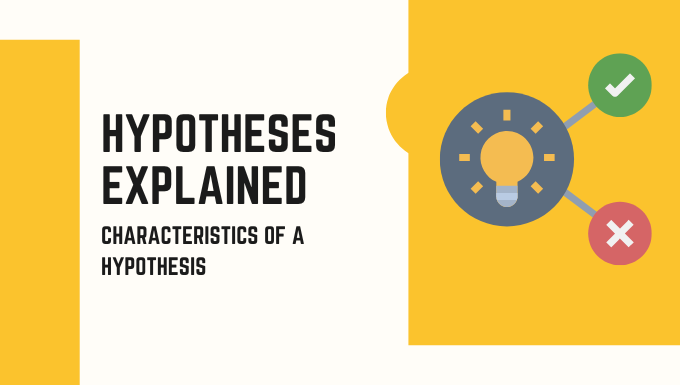
A hypothesis possesses specific characteristics that distinguish it as a testable statement within the scientific method. These characteristics ensure clarity, testability, and relevance, enabling researchers to conduct systematic investigations effectively. Understanding these features is essential for formulating hypotheses that guide meaningful and rigorous scientific inquiry.
A hypothesis exhibits several key characteristics essential for scientific inquiry:
- Testable and Falsifiable: A hypothesis must be capable of being tested through empirical methods and have the potential to be proven false based on observed data.
- Specific and Clear: It should be clearly defined, outlining the specific relationship between variables or the expected outcome of an experiment, providing a clear direction for research.
- Based on Existing Knowledge and Observations: Hypotheses are grounded in previous research, observations, or theoretical frameworks, ensuring they are informed and relevant to the current state of knowledge in the field.
III. Types of Hypotheses
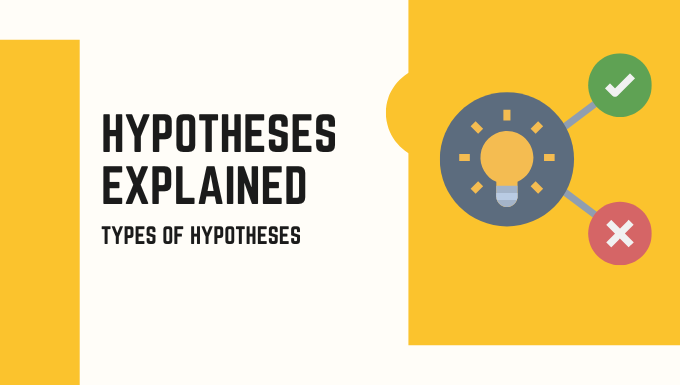
Hypotheses can vary in nature and scope, reflecting different research objectives, relationships between variables, and theoretical frameworks. Understanding the various types of hypotheses allows researchers to tailor their research questions and methodologies to specific investigative needs, enhancing the clarity and precision of scientific inquiry.
Null Hypothesis (or Zero Hypothesis): Definition and Purpose
The null hypothesis (H0) posits that there is no significant effect or relationship between the variables under investigation. It serves as the default assumption in hypothesis testing, against which the alternative hypothesis is compared to determine statistical significance.
Example
There is no difference in test scores between students who study with music and those who study in silence.
Significance:
The null hypothesis sets the baseline for statistical analysis. If the observed data provides sufficient evidence to reject the null hypothesis, it suggests that there is a significant effect or relationship worth further investigation. Failing to reject the null hypothesis indicates that the observed results are likely due to chance, supporting the status quo or existing understanding in the field.
Alternative Hypothesis (or First Hypothesis): Definition and Role
The alternative hypothesis (H1 or Ha) proposes a specific effect, relationship, or difference between the variables being studied, contrasting the null hypothesis. It serves as the primary focus of the research, representing the researcher’s hypothesis of interest.
Example:
Students who study with music will achieve higher test scores compared to those who study in silence.
Importance:
The alternative hypothesis directs the research towards investigating a specific hypothesis-driven question or prediction. Supporting the alternative hypothesis with empirical evidence provides insights into the relationships between variables, contributing to theory development and informing practical applications or interventions in various fields.
IV. Formulating a Hypothesis
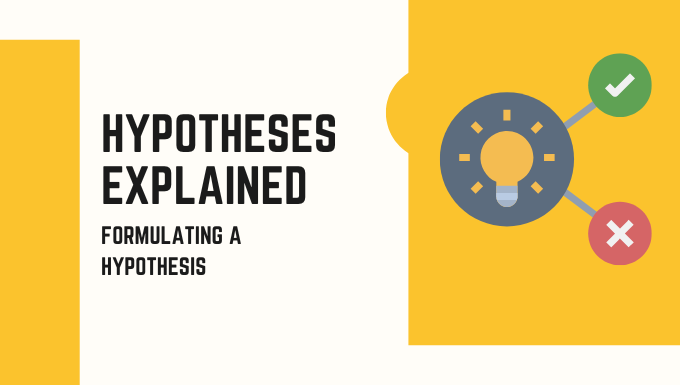
Formulating a hypothesis is a critical step in the research process, requiring careful consideration of the research question, existing literature, and theoretical frameworks. A well-crafted hypothesis provides a clear and testable statement that guides the research design, methodology, and data analysis, ensuring systematic and rigorous investigation of the proposed relationships or effects between variables.
Steps to Develop a Hypothesis
Developing a hypothesis involves a systematic approach to formulate clear, testable statements that guide research inquiries. Here are the steps to develop a hypothesis:
- Identify the Research Topic: Choose a specific research topic or question of interest that warrants investigation.
- Review Existing Literature: Conduct a literature review to understand the current state of knowledge, theories, and findings related to the research topic.
- Define Variables: Clearly define the independent and dependent variables that will be studied and any potential confounding variables that need to be controlled.
- Formulate a Research Question: Based on the identified variables and literature review, formulate a clear research question that the hypothesis will address.
- Draft a Null Hypothesis (H0): Create a null hypothesis that assumes no significant effect or relationship between the variables.
- Draft an Alternative Hypothesis (H1 or Ha): Develop an alternative hypothesis proposing a specific effect, relationship, or difference between the variables.
- Ensure Testability and Clarity: Ensure that the hypotheses are testable through empirical methods and clearly articulated to guide systematic investigation.
- Refine and Revise: Review and refine the hypotheses based on feedback, feasibility, and relevance to ensure they align with the research objectives and available resources.
By following these steps, researchers can develop hypotheses that provide a solid foundation for conducting meaningful, structured, and rigorous scientific investigations.
Tips for Crafting a Clear and Effective Hypothesis
Crafting a clear and effective hypothesis is essential for guiding systematic research and ensuring meaningful results. Here are some tips to consider when formulating your hypothesis:
- Be Specific: Clearly define the variables and the nature of the relationship or effect you are proposing to study.
- Be Testable: Ensure that your hypothesis can be empirically tested through observation, experimentation, or data collection methods.
- Use Clear Language: Write your hypothesis in clear, concise language that is easy to understand, avoiding jargon or ambiguous terms.
- Align with Existing Knowledge: Ground your hypothesis in existing literature and observations, ensuring it is informed by current understanding and theories in the field.
- State the Expected Direction: If applicable, specify the expected direction of the relationship or effect (e.g., positive, negative).
- Avoid Bias: Formulate your hypotheses without bias towards a particular outcome, maintaining objectivity in your research approach.
- Consider Feasibility: Ensure that your hypothesis is feasible to test given the available resources, time, and methodology.
- Seek Feedback: Share your hypotheses with colleagues, mentors, or experts in the field to gain insights, identify potential weaknesses, and refine your statements.
By incorporating these tips, you can craft hypotheses that are clear, testable, and well-aligned with your research objectives, facilitating systematic and rigorous scientific inquiry.
V. Hypothesis Testing
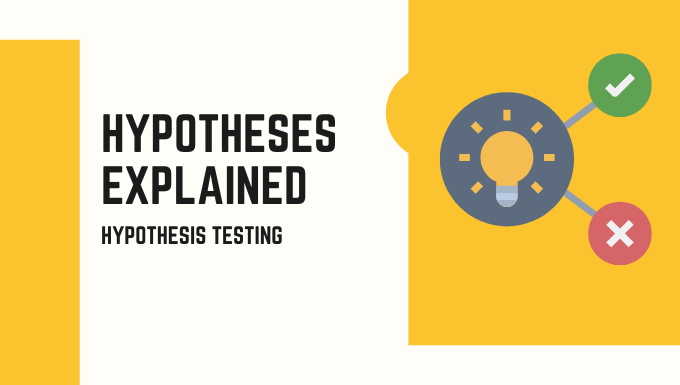
Hypothesis testing is a critical statistical method used in scientific research to evaluate the validity of hypotheses by analyzing and interpreting empirical data. It provides a structured framework for assessing the significance of observed effects or relationships between variables, guiding informed decision-making and theory validation in various fields of study.
Importance of Hypothesis Testing
Hypothesis testing is a fundamental aspect of scientific research and inquiry, serving several important purposes:
- Validity and Reliability: Hypothesis testing ensures the validity and reliability of research findings by providing a systematic method to evaluate the significance of observed results.
- Informed Decision-Making: It guides informed decision-making by determining whether the observed effects or relationships are statistically significant and meaningful.
- Theory Validation and Development: Successful hypothesis testing validates or refutes existing theories, contributing to the advancement and refinement of scientific knowledge and theories.
- Practical Applications: The results of hypothesis testing have practical implications, informing the development of interventions, policies, and strategies in various fields.
- Optimized Resource Allocation: It helps optimize the allocation of resources by identifying which hypotheses warrant further investigation and resource allocation based on their significance and potential impact.
- Critical Thinking and Problem-Solving: Hypothesis testing fosters critical thinking skills by encouraging researchers to analyze data, interpret findings, and draw conclusions based on empirical evidence.
- Transparency and Accountability: It promotes transparency and accountability in research by providing a structured framework for reporting results and conclusions, enhancing the credibility and reproducibility of research findings.
In summary, hypothesis testing is essential for ensuring the rigor, validity, and practical relevance of scientific research, driving advancements in knowledge, theory development, and informed decision-making across various disciplines.
Procedures and Methods for Testing Hypotheses
Testing hypotheses involves a systematic process that employs various procedures and methods to evaluate the significance of research findings. Here are the key procedures and methods commonly used for hypothesis testing:
- Select the Appropriate Statistical Test: Choose the statistical test that is most suitable for the type of data and research design, such as t-tests, ANOVA, regression analysis, chi-square tests, etc.
- Set the Significance Level (α): Determine the significance level (α), typically set at 0.05, to establish the threshold for rejecting the null hypothesis.
- Collect Data: Gather relevant data through experiments, surveys, observations, or other data collection methods, ensuring the data meets the assumptions required for the chosen statistical test.
- Calculate the Test Statistic: Compute the appropriate test statistic based on the selected statistical test and the collected data.
- Determine the Critical Value or P-value: Identify the critical value from the statistical distribution or calculate the p-value associated with the test statistic to determine the probability of obtaining the observed results by chance under the null hypothesis.
- Compare the Test Statistic and Critical Value or P-value: Compare the calculated test statistic to the critical value or p-value to decide whether to reject or fail to reject the null hypothesis.
- Interpret Results: Interpret the results in the context of the research question and hypotheses, considering both statistical significance and practical significance.
- Report Findings: Clearly communicate the findings, including the test statistic, degrees of freedom, critical value or p-value, and conclusions regarding the acceptance or rejection of the null hypothesis, ensuring transparency and reproducibility.
By following these procedures and methods, researchers can systematically evaluate hypotheses, assess the significance of research findings, and draw valid conclusions based on empirical evidence.
Criteria for Accepting or Rejecting Hypotheses
Accepting or rejecting hypotheses in scientific research involves applying specific criteria to evaluate the statistical significance and practical implications of the findings. Here are the criteria commonly used to make decisions about hypotheses:
- Compare the P-value to the Significance Level (α):
- If the p-value is less than or equal to the significance level (α), typically set at 0.05, the null hypothesis is rejected, indicating statistical significance.
- If the p-value is greater than the significance level, the null hypothesis is not rejected, suggesting that the observed results are not statistically significant.
- Assess the Test Statistic against the Critical Value:
- Compare the calculated test statistic with the critical value from the appropriate statistical distribution.
- If the test statistic is greater than the critical value in a one-tailed test or falls outside the critical region in a two-tailed test, reject the null hypothesis.
- If the test statistic does not exceed the critical value, fail to reject the null hypothesis.
- Consider Practical Significance:
- Evaluate the magnitude of the effect size or difference between groups to determine if the observed results are not only statistically significant but also practically meaningful.
- Review Assumptions and Limitations:
- Ensure that the assumptions required for the chosen statistical test are met.
- Consider the limitations of the study, potential confounding variables, and alternative explanations for the results.
- Consult Previous Research and Theoretical Frameworks:
- Compare the findings with existing literature and theoretical frameworks to validate or challenge current knowledge and understanding in the field.
- Replication and Consistency:
- Consider the consistency of the findings across different studies and replications to reinforce the validity and reliability of the results.
By applying these criteria, researchers can make informed decisions about accepting or rejecting hypotheses, ensuring rigorous evaluation of research findings and meaningful interpretation of results in scientific inquiry.
VI. Examples of Hypotheses in Different Fields

Hypotheses are integral to research across various disciplines, guiding investigations and shaping the direction of scientific inquiry. Here, we present examples of hypotheses formulated in different fields to illustrate their diverse applications and relevance in advancing knowledge and understanding within specific domains.
Examples of Hypotheses in Scientific Research
- Biology:
- Hypothesis: Exposure to sunlight increases vitamin D levels in humans.
- Chemistry:
- Hypothesis: Increasing the concentration of reactants speeds up the rate of a chemical reaction.
- Physics:
- Hypothesis: Objects with greater mass require more force to accelerate at the same rate as objects with lesser mass.
- Environmental Science:
- Hypothesis: Increased carbon dioxide levels in the atmosphere contribute to global temperature rise.
- Engineering:
- Hypothesis: Increasing the thickness of insulation reduces energy loss in residential buildings.
These hypotheses in scientific research provide testable statements that guide experiments and observations to explore specific phenomena, relationships, or effects within their respective fields.
Examples of Hypotheses in Social Sciences
- Psychology:
- Hypothesis: Individuals who practice mindfulness meditation experience reduced levels of stress compared to those who do not.
- Sociology:
- Hypothesis: Social media usage is positively correlated with feelings of loneliness among young adults.
- Economics:
- Hypothesis: Increasing minimum wage leads to a decrease in unemployment rates among low-skilled workers.
- Political Science:
- Hypothesis: Voter turnout is higher in countries with compulsory voting laws compared to countries without such laws.
- Education:
- Hypothesis: Implementing technology-based learning tools improves academic performance among elementary school students.
These hypotheses in social sciences aim to explore relationships, behaviors, and phenomena within human societies, guiding research studies and informing policy decisions.
Examples of Hypotheses in Social Business and Economics
- Marketing:
- Hypothesis: Offering discounts increases customer purchase intentions compared to regular pricing strategies.
- Finance:
- Hypothesis: Companies with higher debt-to-equity ratios are more financially leveraged and may face higher financial risks.
- Management:
- Hypothesis: Employee job satisfaction is positively correlated with organizational productivity.
- International Business:
- Hypothesis: Tariff reductions lead to an increase in international trade between countries.
- Entrepreneurship:
- Hypothesis: Entrepreneurs with prior business experience are more likely to succeed in their ventures than first-time entrepreneurs.
These hypotheses in business and economics guide research endeavors to understand various aspects of business operations, market dynamics, financial behaviors, and economic policies, informing strategies and decision-making processes.
Examples of Hypotheses in Health and Medicine
- Nutrition:
- Hypothesis: Consumption of a Mediterranean diet reduces the risk of cardiovascular diseases compared to a standard Western diet.
- Pharmacology:
- Hypothesis: Administration of Drug X decreases symptoms of depression more effectively than a placebo.
- Epidemiology:
- Hypothesis: Regular physical activity decreases the likelihood of developing type 2 diabetes in middle-aged adults.
- Public Health:
- Hypothesis: Implementation of smoke-free policies in public places reduces the incidence of respiratory illnesses in the general population.
- Genetics:
- Hypothesis: Individuals with a specific gene mutation have a higher predisposition to developing certain types of cancer.
These hypotheses in health and medicine guide research efforts to investigate the relationships between various factors, interventions, and health outcomes, contributing to advancements in medical knowledge, treatments, and public health strategies.
VII. Common Mistakes and Pitfalls
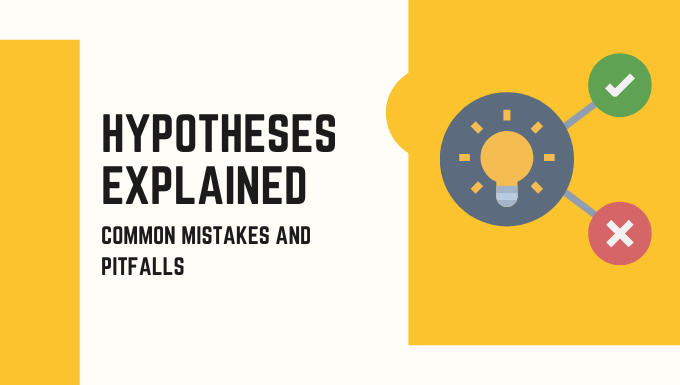
Hypothesis testing requires careful attention to detail and adherence to methodological rigor. However, researchers often encounter common mistakes and pitfalls that can compromise the validity and reliability of their findings. In this section, we highlight some of these common pitfalls to help researchers identify and avoid potential pitfalls in their research endeavors.
Avoiding vague or overly complex hypotheses
One of the common mistakes researchers make when formulating hypotheses is crafting statements that are either too vague or overly complex. Vague hypotheses lack clarity and specificity, making them difficult to test empirically. On the other hand, overly complex hypotheses may encompass multiple variables or conditions, complicating the research design and data analysis process.
Impact:
- Vague Hypotheses: Lack of clarity can lead to ambiguous interpretations and challenges in operationalizing variables, thereby compromising the validity and reliability of the research findings.
- Overly Complex Hypotheses: Complexity can result in convoluted research designs, making it challenging to isolate and examine the specific relationships or effects between variables, potentially leading to inconclusive or misleading results.
Recommendations:
- Be Specific: Clearly define the variables and the expected relationship or effect to ensure clarity and precision in your hypothesis.
- Simplicity is Key: Keep hypotheses concise and focused on a single, clear statement to facilitate straightforward testing and interpretation.
By avoiding vague or overly complex hypotheses, researchers can enhance the clarity, testability, and reliability of their research findings, ensuring meaningful contributions to their respective fields.
Ensuring Alignment between Hypotheses and Research Objectives
Another common pitfall in research is the lack of alignment between hypotheses and research objectives. Hypotheses should directly correspond to the research questions or objectives, guiding the investigation towards the intended outcomes and ensuring the study’s coherence and focus.
Impact:
- Misalignment: A disconnect between hypotheses and research objectives can lead to confusion, inconsistencies, and potential deviations from the intended research direction, compromising the integrity and validity of the study.
Recommendations:
- Clarify Objectives: Clearly define the research objectives and questions before formulating hypotheses to ensure alignment and coherence between them.
- Review and Revise: Regularly review and revise hypotheses to ensure they accurately reflect the research objectives and address the intended outcomes of the study.
By ensuring alignment between hypotheses and research objectives, researchers can maintain a clear and focused approach to their investigations, facilitating systematic and meaningful exploration of the research questions and objectives.
Conclusion: Hypotheses Explained
Hypotheses play a crucial role in guiding research endeavors across diverse disciplines, serving as the foundation for systematic inquiry and empirical testing. This quick guide has provided an overview of what hypotheses are, their significance, key characteristics, and common pitfalls to avoid.
Understanding how to formulate, test, and interpret hypotheses effectively is essential for ensuring the validity, reliability, and impact of research findings. By adhering to the principles outlined in this guide, researchers can enhance the clarity, coherence, and rigor of their studies, contributing to advancements in knowledge, theory development, and practical applications within their respective fields.